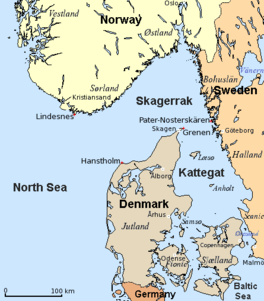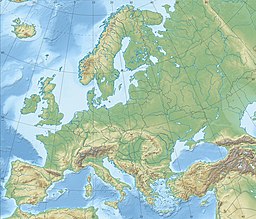|
Kattegat
The Kattegat (Danish: [ˈkʰætəkæt]; Swedish: Kattegatt [ˈkâtːɛˌɡat]) is a 30,000 km2 (12,000 sq mi) sea area bounded by the peninsula of Jutland in the west, the Danish straits islands of Denmark and the Baltic Sea to the south and the Swedish provinces of Bohuslän, Västergötland, Halland and Scania in Sweden in the east. The Baltic Sea drains into the Kattegat through the Danish straits. The sea area is a continuation of the Skagerrak and may be seen as a bay of the North Sea and North Atlantic Ocean, though this is not the case in traditional Scandinavian usage. The Kattegat is a rather shallow sea and can be dangerous to navigate due to many sandy, stony reefs and the tricky shifting currents. In modern times, artificial seabed channels have been dug, many reefs have been dredged either by sand pumping or boulder clearance,[1] and a well-developed light signaling network has been installed to protect the heavy international traffic on this small sea. There are several large cities and major ports on the Kattegat, including, in descending size, Gothenburg, Aarhus, Aalborg, Halmstad, Varberg and Frederikshavn. Geography According to the definition established in a 1932 convention signed by Denmark, Norway and Sweden (registered in the League of Nations Treaty Series 1933–1934), the northern boundary between the Kattegat and Skagerrak is at the northernmost point of Skagen on Jutland and the southern boundary towards Øresund is at the tip of Kullen Peninsula in Scania.[2] Major waterways that drain into the Kattegat are the rivers of Göta älv at Gothenburg, together with the Lagan, Nissan, Ätran and Viskan in the province of Halland on the Swedish side, and the Danish river of Gudenå in Jutland. The main islands of the Kattegat are Samsø, Læsø and Anholt; due to their relatively dry climate, the last two are, perceived to belong to "the Danish desert belt". A number of noteworthy coastal areas abut the Kattegat, including the Kullaberg Nature Reserve in Scania, , which contains a number of rare species and a scenic rocky shore, the town of Mölle, which has a picturesque harbour and views into the Kullaberg, and Skagen at the northern tip of Denmark. Since the 1950s, a bridge project usually referred to as Kattegatbroen (the Kattegat Bridge) connecting Jutland and Zealand across the Kattegat has been considered. Since the late 2000s, the project has seen a renewed interest from several influential politicians in Denmark. The bridge is usually envisioned as connecting Hov (a village south of Odder in the Aarhus area) with Samsø and Kalundborg.[3][4] ExtentThe International Hydrographic Organization defines the limits of the "Kattegat, Sound and Belts" (that is, the Kattegat, Øresund, Great Belt, and Little Belt) as follows:[5]
EtymologyAccording to Den Store Danske Encyklopædi and Nudansk Ordbog, the name is from the Dutch words katte 'cat's' and gat 'gate, passage'. It derives from late medieval navigation jargon, in which captains of the Hanseatic trading fleets would compare the Danish straits to a passage so tight that even a cat would have difficulty squeezing its way through, owing to the many reefs and shoals.[6][7] At one point, the passable waters were a mere 3.84 km (2.07 nmi; 4,200 yd) wide. The name of the Copenhagen street Kattesundet has a comparable etymological meaning, namely 'narrow passage', lit. 'the cat's strait'.[7] An archaic name for both the Skagerrak and Kattegat was the Norwegian Sea or Jutland Sea (Knýtlinga saga mentions the name Jótlandshaf). Its ancient Latin name was Sinus Codanus.[8] HistoryControlling and having access to the Kattegat have been important throughout the history of international seafaring. Until the completion of the Eider Canal in 1784, the Kattegat was the only sea route into and out of the Baltic region.[9] Beginning in 1429 in the Middle Ages, the Danish royal family – and later the state of Denmark – prospered greatly from the Sound dues, a toll charged for passage through the Øresund, while Copenhagen sheltered and repaired ships and provided trade opportunities and protection from piracy. The dues were eventually lifted, in 1857. BiologyThe salinity in the Kattegat has a pronounced two-layer structure. The upper layer's salinity is between 18‰ and 26‰, while that of the lower layer (separated by a strong halocline at around 15 m (49 ft)) has a salinity between 32‰ and 34‰. The lower layer consists of inflowing seawater from the Skagerrak, with a salinity on par with most other coastal seawaters, while the upper layer, consisting of inflowing seawater from the Baltic Sea, has a much lower salinity, comparable to brackish water, but still a great deal higher than the rest of the Baltic. These two opposing flows transport a net surplus of 475 km3 (114 cu mi) of seawater from the Baltic to the Skagerrak every year.[10] During strong winds, the Kattegat's layers are completely mixed in places such as the Great Belt, making the overall salinity highly variable. This leads to some distinctive conditions for sealife in the area.[11] Cold seeps, known locally as bubbling reefs (Danish: boblerev), can be found in the northern Kattegat. Unlike those in most other places (including the North Sea and Skagerrak), the Kattegat's cold seeps are at relatively shallow depths, generally from 0 to 30 m (0–100 ft) below the surface.[12][13] The seeps rely on methane deposited during the Eemian period and during calm weather the bubbles can sometimes be seen on the surface of the water.[13] Carbonate cementation and lithification form slaps or pillars up to 4 m (13 ft) tall and support a rich biodiversity.[12][13] Due to their distinct properties, the Kattegat bubbling reefs are under protection and are recognised by the European Union (EU) as a Natura 2000 habitat (type 1180).[14] Ecological collapseThe Kattegat, characterised by widespread anoxia,[15] was one of the first marine dead zones to be noted in the 1970s, when scientists began to study the effects of heavy industry on the natural world.[16][17] Since then, research has leant much insight into processes like eutrophication, and how to deal with it. Since the first Action Plan for the Aquatic Environment in 1985, Denmark and the EU have begun costly, far-reaching domestic projects to stop, repair and prevent these environmentally destructive and economically damaging processes[18] and are now busy implementing the fourth Action Plan. The action plans sum up a broad range of initiatives and include the so-called Nitrate Directives.[19] The action plans have generally been viewed as a success, although the work is not finished and not all goals have been met yet.[20] Protections and regulation  Due to its very heavy sea traffic and many large coastal settlements, the Kattegat has been designated as a Sulphur Emission Control Area as part of the Baltic Sea since 2006. As from 1 January 2016 the benchmark for sulphur in fuels was lowered to 0.1%.[21] Several large areas of the Kattegat are designated under Natura 2000 and various bird protections such as the Ramsar Convention. The remaining larger shallow reefs are among the protections, as they are important spawning and feeding grounds for fish and marine mammals and support a thriving but threatened biodiversity. Protected areas include: Denmark[22]
Sweden[23]
Gallery
See alsoReferences
External linksWikimedia Commons has media related to Kattegat.
|
||||||||||||||||||







